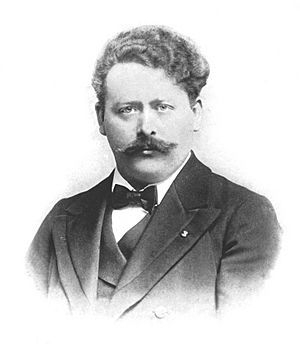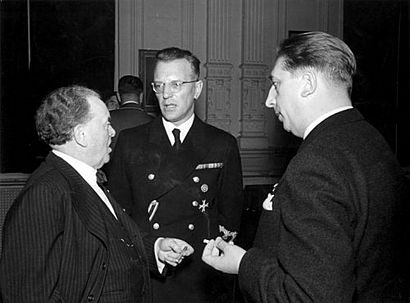Willem Mengelberg facts for kids
Quick facts for kids
Willem Mengelberg
|
|
|---|---|
 |
|
| Born |
Joseph Wilhelm Mengelberg
28 March 1871 Utrecht, Netherlands
|
| Died | 21 March 1951 (aged 79) Zuort, Sent, Switzerland
|
| Occupation | Conductor |
| Years active | 1891–1945 |
| Musical career | |
| Genres | Classical |
| Associated acts | National Radio Orchestra of Romania Concertgebouw London Symphony New York Philharmonic |
Willem Mengelberg (born March 28, 1871, died March 21, 1951) was a famous Dutch conductor. He was known for leading the Concertgebouw Orchestra in Amsterdam. He often played music by composers like Beethoven, Brahms, Mahler, and Strauss. Many people think he was one of the best orchestra conductors of the 20th century.
Contents
Willem Mengelberg's Life Story
Willem was born in Utrecht, Netherlands. He was one of fifteen children! His father, Friedrich Wilhelm Mengelberg, was a sculptor. Willem studied music in Utrecht and then went to a music school in Cologne, Germany. There, he learned to play the piano and compose music.
In 1891, when he was just 20 years old, Willem became the General Music Director in Lucerne, Switzerland. He led an orchestra and a choir, taught piano, and even composed his own music.
Four years later, in 1895, Willem became the main conductor of the Concertgebouw Orchestra in Amsterdam. He held this important job for 50 years, until 1945.
Important Music Premieres
During his time with the Concertgebouw Orchestra, Mengelberg helped introduce many new and important pieces of music.
For example, in 1898, the famous composer Richard Strauss dedicated his piece Ein Heldenleben (A Hero's Life) to Mengelberg and the orchestra. Strauss said he finally found an orchestra that could play all the difficult parts perfectly.
Mengelberg also conducted the first performances of other famous works. On March 29, 1939, he led the first performance of the Violin Concerto No. 2 by Béla Bartók. Later that year, on November 23, 1939, he premiered the Peacock Variations by Zoltán Kodály.
Mengelberg and Gustav Mahler
Mengelberg started a long tradition of performing Gustav Mahler's music with the Concertgebouw. He met Mahler in 1902, and they became friends. Mengelberg invited Mahler to conduct his own Third Symphony in Amsterdam in 1903.
On October 23, 1904, Mahler conducted his Fourth Symphony twice in one concert! Mahler thought this idea was brilliant. Mahler often visited the Netherlands to share his music with Dutch audiences. He even changed some of his symphonies while practicing with the Concertgebouw Orchestra. This made them sound better in the concert hall. Because of this, the Concertgebouw is very famous for playing Mahler's music. In 1920, Mengelberg held a special Mahler Festival, where all of Mahler's music was performed in nine concerts.
Mengelberg also started a tradition in 1899. Every year on Palm Sunday, the Concertgebouw Orchestra performs Johann Sebastian Bach's St Matthew Passion.
Some people, like composer Willem Pijper, felt that Mengelberg did not support Dutch composers enough, especially after 1920.
Conducting in New York
Mengelberg was also the music director for the New York Philharmonic Orchestra from 1922 to 1928. From 1926, he shared the conducting job with Arturo Toscanini. These two conductors had different ideas about how to play music and even how to practice. This caused some disagreements among the musicians, and Mengelberg eventually left the orchestra.
Mengelberg made many recordings with the New York Philharmonic. One famous recording was of Richard Strauss's Ein Heldenleben in 1928.
Later Life and Challenges
In 1933, Mengelberg faced some public criticism. He had moved to Switzerland to avoid high taxes in the Netherlands. This was called the "Mengelberg Crisis."
People described Mengelberg as a very strict conductor, like a "Napoleon of the orchestra." He was known for being very bossy with his musicians during rehearsals.
The most difficult part of Mengelberg's life story involves his actions during World War II. When the Nazis occupied the Netherlands from 1940 to 1945, Mengelberg continued to conduct in Germany and in countries that Germany had taken over. He was even photographed with Nazi officials. Some people believe he was politically naive, meaning he didn't understand the seriousness of the situation. Others thought he had a "blind spot" for anything German because of his own family background.

After the war, in 1945, a special council in the Netherlands banned him from conducting there for life. In 1947, the ban was reduced to six years. Also in 1947, Queen Wilhelmina took back an award she had given him. He still received a pension from the orchestra until 1949. Mengelberg went to live in Zuort, Switzerland, where he stayed until he died in 1951. This was just two months before his ban was supposed to end.
Willem Mengelberg was related to other musicians. He was a distant cousin of the music expert and composer Rudolf Mengelberg. He was also the uncle of conductor and composer Karel Mengelberg, who was the father of pianist and composer Misha Mengelberg.
How Willem Mengelberg Conducted
The New Grove Dictionary of Music and Musicians describes Mengelberg as a "martinet" (a very strict person) who loved long and detailed rehearsals. He also wasn't afraid to make changes to a composer's music if he thought it would make it sound clearer.
Mengelberg's recordings with the Concertgebouw Orchestra often show a special way of playing called portamento. This is when string players slide their fingers from one note to another. A music expert named Robert Philip noticed that Mengelberg's recordings with other orchestras didn't have this same sliding sound. This means it was a special style he developed with the Concertgebouw over many years of practice. This style also required all the string players to use the same fingerings, which was unusual for the time.
Mengelberg also changed the speed of the music (called tempo) a lot, even more than other conductors of his time. Some people love how he changed the tempo, saying it made the music very expressive. Others criticize it, saying it sometimes made the music's overall shape unclear.
Willem Mengelberg's Recordings
Mengelberg made many commercial recordings. In the United States, he recorded with the New York Philharmonic for Victor and Brunswick Records. In Amsterdam, he recorded with the Concertgebouw Orchestra for Columbia, Odeon, and Decca. He also recorded with the Concertgebouw Orchestra and the Berlin Philharmonic for Telefunken. After he died, Philips released recordings of his live performances that were captured by Dutch radio.
Some of his most famous recordings include:
- Richard Strauss's Ein Heldenleben and Don Juan
- Symphonies by Beethoven, Tchaikovsky, and Brahms
- Bach's St Matthew Passion
- Gustav Mahler's Symphony No. 4 and the Adagietto from his Symphony No. 5
His performances are known for being very expressive and having a lot of freedom in tempo. This is especially clear in his Mahler Fourth Symphony recording and the St Matthew Passion. Because of this unique style, his recordings are sometimes debated among classical music fans. Some find them amazing, while others find them difficult to listen to.
Many of his recorded performances, including some live concerts from World War II, have been re-released on LPs and CDs. He was known for German music, but he also made a powerful recording of César Franck's Symphony in D minor with the Concertgebouw Orchestra.
Because of the six-year ban, Mengelberg did not make any new recordings after 1945. Some of his performances in Amsterdam were recorded using a new German tape recorder called the Magnetophon. This made the sound quality very good for that time.
There are also sound films of Mengelberg conducting the Concertgebouw Orchestra during live concerts. One example is a 1931 performance of Weber's Oberon overture. His 1939 recording of Bach's St Matthew Passion was recorded using a special Philips system that used film as the audio recording material.
Images for kids
See also
 In Spanish: Willem Mengelberg para niños
In Spanish: Willem Mengelberg para niños



